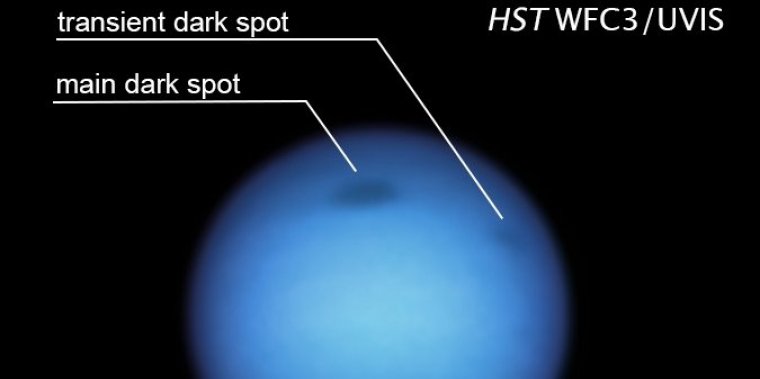| News / Science News |
Dark Storm on Neptune Reverses Direction, Possibly Shedding a Fragment
Astronomers using NASA's Hubble Space Telescope watched a mysterious dark vortex on Neptune abruptly steer away from a likely death on the giant blue planet.

The smaller dark spot in this Hubble image may have been a piece of the giant storm that broke off as the larger vortex approached the equator. Credits: NASA, ESA, STScI, M.H. Wong (University of California, Berkeley), and L.A. Sromovsky and P.M. Fry (University of Wisconsin-Madison)
The storm, which is wider than the Atlantic Ocean, was born in the planet's northern hemisphere and discovered by Hubble in 2018. Observations a year later showed that it began drifting southward toward the equator, where such storms are expected to vanish from sight.
To the surprise of observers, Hubble spotted the vortex change direction by August 2020, doubling back to the north.
Equally as puzzling, the storm was not alone. Hubble spotted another, smaller dark spot in January this year that temporarily appeared near its larger cousin. It might possibly have been a piece of the giant vortex that broke off, drifted away, and then disappeared in subsequent observations.
The large storm, which is 4,600 miles across, is the fourth dark spot Hubble has observed on Neptune since 1993. Two other dark storms were discovered by the Voyager 2 spacecraft in 1989 as it flew by the distant planet, but they had disappeared before Hubble could observe them.
Since then, only Hubble has had the sharpness and sensitivity in visible light to track these elusive features, which have sequentially appeared and then faded away over a duration of about two years each. Hubble uncovered this latest storm in September 2018.
Neptune's dark vortices are high-pressure systems that can form at mid-latitudes and may then migrate toward the equator.
They start out remaining stable due to Coriolis forces, which cause northern hemisphere storms to rotate clockwise, due to the planet's rotation. (These storms are unlike hurricanes on Earth, which rotate counterclockwise because they are low-pressure systems.)
However, as a storm drifts toward the equator, the Coriolis effect weakens and the storm disintegrates.
In computer simulations by several different teams, these storms follow a more-or-less straight path to the equator, until there is no Coriolis effect to hold them together. Unlike the simulations, the latest giant storm didn't migrate into the equatorial "kill zone."
The Hubble observations also revealed that the dark vortex’s puzzling path reversal occurred at the same time that a new spot, informally deemed "dark spot jr.," appeared.
The newest spot was slightly smaller than its cousin, measuring about 3,900 miles across. It was near the side of the main dark spot that faces the equator — the location that some simulations show a disruption would occur.
The researchers are continuing to analyze more data to determine whether remnants of dark spot jr. persisted through the rest of 2020.
It's still a mystery how these storms form, but this latest giant dark vortex is the best studied so far. The storm's dark appearance may be due to an elevated dark cloud layer, and it could be telling astronomers about the storm's vertical structure.
Another unusual feature of the dark spot is the absence of bright companion clouds around it, which were present in Hubble images taken when the vortex was discovered in 2018. Apparently, the clouds disappeared when the vortex halted its southward journey.
The bright clouds form when the flow of air is perturbed and diverted upward over the vortex, causing gases to likely freeze into methane ice crystals. The lack of clouds could be revealing information on how spots evolve, say researchers. (NASA)
YOU MAY ALSO LIKE





